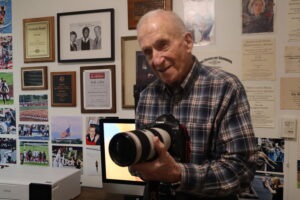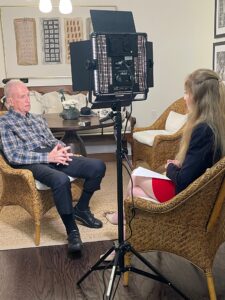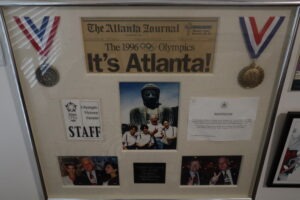Bob Cohn Revolutionizes the PR Industry
Published on April 13, 2023, at 5:34 p.m.
by Morgan Perkins.
A young boy inspired by his uncle’s journalism career covering the New York Giants went on to revolutionize the public relations industry through bold, creative ideas. Burson Cohn & Wolfe co-founder Bob Cohn has touched nearly every part of the industry — from working as a journalist and PR practitioner to co-founding the world’s third-largest public relations firm. Through his lived experiences, he continues to impact the industry by inspiring young professionals to seek a meaningful career as Cohn’s.
Early career

Cohn grew up in the journalism world and believed that it was his destiny. Cohn started his career as a student at The University of Alabama, where he was the sports editor of The Crimson White and in 1959 was elected editor of the student newspaper. Cohn reflected on how The Crimson White has evolved from a social publication to a newspaper that focuses on exposing the truth. Cohn also had experience directly with UA’s athletic teams. During Paul Bryant’s first couple of years as head coach of the Crimson Tide, Cohn worked closely with the team as a student assistant to the press director.
After his undergraduate studies at UA, Cohn worked as a journalist for the Montgomery Advertiser, where he covered the Freedom Riders. Congressman John Lewis recalled that if you had a pen or pencil, camera or recording device, the Klan attacked the media before the bus arrived. Cohn fled from the scene and returned when the Riders came and Lewis was badly beaten.
Cohn continued his career as a journalist at the Augusta Chronicle in Georgia, where he won almost every type of award a news reporter could win. The Associated Press awarded Cohn eight news writing and photography awards from 1964 to 1966, Cohn shared. His home on UA’s campus is filled with certificates, honors, photographs and other memorabilia that display his life’s achievements.
Cohn also covered historical events such as the 1968 Democratic Convention in Chicago that quickly became violent when peaceful protests turned into riots. According to the History Channel, “Eyewitnesses report it was a scene of unrestrained bloodshed and chaos.” Cohn described his experience as a journalist during the convention as “absolutely nuts.”
Career shift
Although Cohn succeeded in journalism, his career shifted to the public relations industry for personal and financial reasons.

“My family began to grow, and newspapers didn’t pay well,” Cohn said. He decided to enter the public relations world with no prior background in the industry, other than his notion that he could always return to journalism if he failed at PR.”
In 1970, Cohn and Norman Wolfe founded Cohn & Wolfe, which would eventually transform from “a little agency with four account people and two secretaries into a national and global brand and in the process became an incubator that produced some of Atlanta’s top public relations professionals,” according to Mitch Leff, a guest columnist at the Saporta Report.
Cohn explained one of the most nerve-wracking moments of his career was when he presented to the chairman of Coca-Cola. The chairman was enthralled with Cohn and believed he presented “a treasure trove of ideas,” Cohn said. Almost all of Cohn’s ideas, 20 out of 21, were executed. “All throughout my career we created breakthrough programs. Ideas that had never been done before. We started off by asking, “What can’t you do?” And we did it,” he said.
Cohn & Wolfe was eventually bought by Young & Rubican, a global marketing communications company. Young & Rubican ultimately sold Cohn & Wolfe to WPP in 2000, so WPP owned both Cohn & Wolfe and Burson-Marsteller and merged the companies into Burson Cohn & Wolfe in 2018. “Even though Burson-Marsteller had a great reputation, Cohn & Wolfe came out on top because we were the creative people, and WPP wanted creative public relations,” Cohn explained.
Some of Cohn & Wolfe’s most well-known clients were Reebok, NASCAR, Six Flags, Royal Caribbean, Hands Across America, Chick-fil-A and Home Depot. Cohn & Wolfe opened the first Courtyard by Marriott in Atlanta and 250 more across the nation after that.
The firm impacted countless different industries and implemented creative campaigns that had a lasting effect on organizations’ structures. For example, when Cohn & Wolfe represented Delta airlines, the company only had two runways in Atlanta. There was a lot of opposition to opening additional runways; however, Cohn & Wolfe were able to overcome the resistance to build three more runways for the airline.

Cohn is most proud of his work with Coca-Cola for the Olympic Games. Cohn shared how the Olympics originally did not allow commercial sponsorships at the venues, but Cohn & Wolfe was able to find a way around the regulations. The Olympic Committee was shorthanded for money for the 1988 Calgary Olympic Games, and Coca-Cola provided a way for the committee to receive extra funding in exchange for publicity. Coca-Cola sponsored the creation of the only World Chorus in Olympic history, where kids from around the world sang at the opening ceremony.
“If you look at the publicity value of the world chorus, it’s unbelievable. When the singing was taking place, there was coverage. When the kids came to the United States, there was coverage. Billions of people watched Jim McCay of ABC-TV describe Coca-Cola’s sponsorship as the chorus, decked out in Coke uniforms, sang in both the opening and closing ceremonies,” Cohn explained.
However, the most monumental campaign for Coca-Cola that Cohn was a part of was for the 2004 Athens Olympic Games. Cohn pitched the idea of having a global torch marathon relay in 35 cities around the world. Millions of people showed up to see the 26-mile torch relay through the middle of their cities. Overall, the campaign led to “$150 million in incremental marketing and earned media,” Cohn said.
Cohn also had the honor of running three torches himself, during the 1996 Atlanta Olympic Games, 2002 Salt Lake City Olympic Games and 2004 Athens Olympic Games.
Retirement and outreach
Throughout Cohn’s retirement, he has remained active by attending UA’s sporting events and pursuing his love for photography. Cohn continues to contribute to the communications industry through his interactions with students and by passing along his wisdom from more than 40 years in the field.
Most recently, Cohn worked with UA’s electronic news production class (JCM 490) as students created a feature broadcast story and digital content on Cohn in his home. Chandra Clark, UA journalism and creative media professor who has a Ph.D. in communication, broadcast and journalism, explained how she was trying to teach her students what makes a good story and how to produce a story that has meaning. Clark also shared her observations of Cohn and his interactions with her students.
“He was very intentional about encouraging the students and paying attention to their individual contributions. It made quite an impression on them,” Clark said.

While Clark’s students were impressed with Cohn’s résumé and experiences, they were more impressed with him as a person. “He’s truly such an incredible man. It was an honor to work with him and get to know him,” Chaney McCorquodale, reporter for the JCM 490 feature broadcast story, said. She noted how Cohn’s personality was both fierce and gentle because of his independence and humor.
McCorquodale also recounted the ample stories Cohn told about his experiences working in the industry and how he inspired her to live a life worth sharing with future generations.
Tori Stincer, field producer for the JCM 490 feature broadcast story, highlighted her experience with Cohn, remarking how she never imagined meeting someone who has touched an Olympic torch. “We say UA is where legends live, and this is where legends are created. But I feel when we talk about it, we don’t always get to meet and interact with them,” Stincer said.
Cohn understood the value of passing along his stories and the lessons he has learned to the next generation, Stincer said. However, he was incredibly humble when discussing his accomplishments, she said.
When asked what contributed the most to his successful career, Cohn said, “I believe creativity and determination to succeed are the keys to success.” Cohn has seen almost all his innovative ideas flourish in the public relations world and continues to inspire young professionals to accomplish the same.
The University of Alabama’s electronic news producing class created a feature broadcast story that highlights Bob Cohn’s milestones throughout his career in the journalism and public relations industry.




